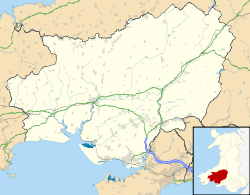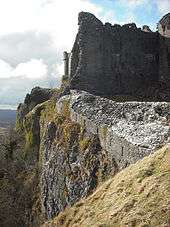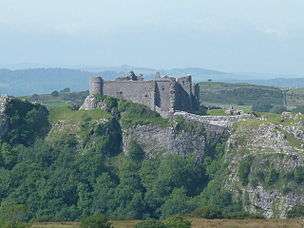Carreg Cennen Castle
| Carreg Cennen Castle | |
|---|---|
| Carmarthenshire, Wales | |
|
The south wall and cliff face of Carreg Cennen Castle | |
 Carreg Cennen Castle | |
| Coordinates | grid reference SN66841911 Postcode: SA19 6UA |
| Site information | |
| Condition | Ruined |
| Site history | |
| Materials | local Carboniferous Limestone |
| Battles/wars | Surrendered to Owain Glyndŵr following a siege. |
| Events | Demolition by Yorkists in Wars of the Roses |
Listed Building – Grade I | |
Carreg Cennen Castle (Welsh: Castell Carreg Cennen meaning castle (on the) rock (above the) Cennen) is a castle near the River Cennen, in the village of Trap, four miles south of Llandeilo in Carmarthenshire, Wales. The castle is within the Brecon Beacons National Park, and its location has been described as spectacular, due to its position above a limestone precipice.[1][2] It has been in a ruinous state since 1462 and is now in the care of Cadw, the Welsh Government historic environment service.
Description
Carreg Cennen Castle consists of a strongly-walled and towered square court. There are six towers, all of different shapes, including a great twin-towered gatehouse on the north side.[3] A range of apartments on the east side of the inner court, or ward, includes a hall, kitchens, chapel, and the so-called 'King's Chamber'. This chamber has a well-carved stone fireplace, and traceried windows, one facing into the courtyard, the other outwards commanding impressive views to the south. These date from the late 13th or early 14th century.[3]


The castle is protected by limestone cliffs to the south and rock-cut ditches to the west. To the north and east there is an outer ward, and within that a barbican, gatehouse. Three drawbridges over deep pits protected the access to the inner ward. In the south-east corner of the inner ward steps lead to a vaulted passage and a natural cave beneath the castle, which leads deep into the hillside. A freshwater spring rises in the cave, which would have been a useful supplement during dry weather when the castle would have had difficulty harvesting rainwater in filling the rainwater cisterns. The castle is under the care of Cadw, who have stabilised and, to a limited extent, restored some of the remains. The castle is accessed via a steep climb up the hill from Castell Farm, which is near the car park. A large threshing barn has been converted to tearooms and a shop, whilst the majority of the farm buildings, around a traditional farmyard, retain their agricultural purposes. Since 1982 these have been part of a farm park with rare and unusual breeds of cows and sheep.[4] This castle did not have a keep as such; the gatehouse acted as the castle's keep because this was the tallest part of the Castell Carreg.
Geology
The Carreg Cennen Disturbance, a zone of ancient geological faults and folds stretching from Pembrokeshire to Shropshire, gains its name from this location where it is most impressively revealed. The rocky outcrop on which the castle is perched is an isolated block of Carboniferous Limestone trapped within two faults which form a part of the disturbance. In contrast, the immediately surrounding countryside is underlain by Old Red Sandstone.[5] This disturbance is probably also responsible for the alignment of the Afon Cennen to the west of this location where the river follows the line of the fault for over 2.5 mi / 4 km because firstly glaciers during the Ice Age then more recently the river have found it easier to erode these deformed rocks.
Prehistoric evidence
Human remains found at the site date human activity here back to prehistoric times. The site may well have also been an Iron Age hillfort.
Roman coins from the 1st and 2nd century have also been found, although it is unlikely the Romans occupied this site on a permanent basis.
Early castle
The first masonry castle was probably built by the Lord Rhys, who died in 1197, and it remained a possession of the Deheubarth dynasty for the next 50 years. In 1248 Rhys Fychan ap Rhys Mechyll's mother Matilda de Braose, to spite her son, granted the castle to the Norman English, but before the English took possession of it Rhys captured the castle.
For the next 30 years it changed hands frequently between Rhys and his uncle Maredudd who were fighting for control of the Kingdom of Deheubarth. In 1277 it was captured by the English, recaptured by the Welsh in 1282 and in English hands again the following year.
In 1283 Edward I granted the castle to John Giffard, the commander of the English troops at Cilmeri where Llywelyn ap Gruffudd (The Last) was killed. Giffard was probably responsible for the remodelled castle we see today.
Owain Glyndwr Rebellion
In early July 1403 Owain Glyndŵr, together with 800 men, attacked Carreg Cennen, but, although inflicting severe damage to the walls, failed to take the castle. It was defended against Glyndwr's forces, who laid siege to it for several months, with Owain himself present, by a man who was to marry one of Glyndwr's daughters just a few years later, Sir John Scudamore of Herefordshire.
Wars of the Roses
The damage was repaired in 1409. However, in 1461, during the Wars of the Roses, Carreg Cennen became a Lancastrian stronghold. A Yorkist force subsequently captured the castle and set about demolishing it with a team of 500 men.
Recent history
Ownership of the castle passed to the Vaughan and Cawdor families, and from the 18th century it started to attract artists (Turner sketched the castle in 1798). The second Earl Cawdor began an extensive renovation in the 19th century, and in 1932 Carreg Cennen was given to the guardianship of the Office of Works. In the 1960s Carreg Cennen Castle was acquired by the Morris family of Castell Farm, when Lord Cawdor's legal team inadvertently made a mistake in the wording of the deeds and included the castle as part of the farm. Today, the castle remains privately owned by Margaret and Bernard Llewellyn, daughter and son in law of the late Mr. Gwilim Morris. The castle is now maintained by Cadw.[6] It is open daily from 9.30am to 6.30pm between April and October and 9.30 to 4pm between November and March (closed Christmas Day).[7]
Rail Access
The nearest station is Ffairfach on the Heart of Wales Line.
See also
- Castles in Great Britain and Ireland
- List of Cadw properties
- List of castles in Wales
- The Gauntlet, a children's historical novel set at Carreg Cennen Castle
Notes
- ↑ Carreg Cennen - Brecon Beacons National Park Authority Archived 7 February 2009 at the Wayback Machine.
- ↑ "Carreg Cennen". Ingot. Richard Thomas and Baldwins, house journal of the Welsh steelworks. March 1956.
...most romantically situated of all Welsh castles...
- 1 2 Lewis, J.M. (2006). Carreg Cennen Castle. Cardiff: Cadw: Welsh Historic Monuments. ISBN 1-85760-237-4.
- ↑ Castell Farm, by Bernard Llewellyn, in Lewis, 2006.
- ↑ http://www.largeimages.bgs.ac.uk/iip/mapsportal.html?id=1001722 online version of BGS geological map sheet 230
- ↑ Lloyd, T.; Orbach, J.; Scourfield, R. (2006). Carmarthenshire and Ceredigion. Yale University Press.
- ↑ Cadw website page for Carreg Cennen Accessed 9 March 2014
External links
| Wikimedia Commons has media related to Carreg Cennen Castle. |
- www.geograph.co.uk : photos of Carreg Cennen and surrounding area
- Aerial photographs of Carreg Cennen Castle taken by the Royal Commission on the Ancient and Historical Monuments of Wales
- History of Castell Carreg Cennen
Coordinates: 51°51′17″N 3°56′06″W / 51.8546°N 3.9349°W
